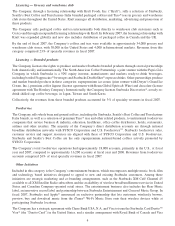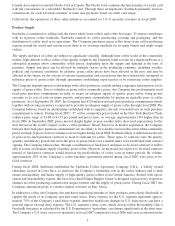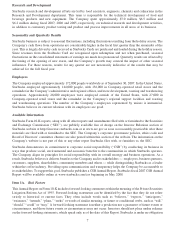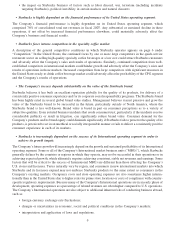Starbucks 2007 Annual Report Download - page 15
Download and view the complete annual report
Please find page 15 of the 2007 Starbucks annual report below. You can navigate through the pages in the report by either clicking on the pages listed below, or by using the keyword search tool below to find specific information within the annual report.•Increased leverage may harm the Company’s financial condition and results of operations.
As of September 30, 2007, Starbucks had approximately $5.0 billion in minimum future rental payments under non-
cancelable operating leases and $3.1 billion of total liabilities on a consolidated basis. Included in total liabilities are
aggregate principal indebtedness of $710 million under outstanding commercial paper and $550 million under ten-year
notes issued in an August 2007 underwritten registered public offering. The Company will incur additional operating
lease obligations, largely driven by new store openings, and may incur additional indebtedness, subject to the limitations
contained in its financing agreements. The recent increase in the Company’s level of financial obligations has had, and
any future increase (which may or may not occur) will have, several important effects on the Company’s future
operations, such as:
• additional cash requirements to support the payment of rents and interest on outstanding indebtedness;
• possible increased vulnerability to adverse changes in general economic and industry conditions, as well as
to competitive pressure;
• possible limitations on the Company’s ability to obtain additional financing for working capital, capital
expenditures, general corporate and other purposes; and
• possible limitations on the Company’s flexibility in planning for, or reacting to, changes in its business and
its industry.
The Company’s ability to satisfy its lease obligations and make payments of principal and interest on its
indebtedness depends on its future performance, which will be subject to general economic conditions, industry
cycles and financial, business and other factors affecting its consolidated operations, many of which are beyond the
Company’s control. If Starbucks is unable to generate sufficient cash flow from operations in the future to satisfy its
financial obligations, it may be required, among other things:
• to seek additional financing in the debt or equity markets;
• to refinance or restructure all or a portion of its indebtedness;
• to sell selected assets; or
• to reduce or delay planned capital or operating expenditures.
Such measures might not be sufficient to enable Starbucks to satisfy its financial obligations. In addition, any such
financing, refinancing or sale of assets might not be available on economically favorable terms.
The Company’s existing strong cash flow and capital structure mitigate the current risk associated with leverage.
Management expects future cash flows to be sufficient to meet operating expenses, debt service costs, and capital
expenditures required to support projected new store openings and investments in existing and new markets. In
addition, management does not expect to increase leverage to levels that would inhibit the Company’s access to
capital markets in the event of short-falls in anticipated operating cash flow.
Item 1B. Unresolved Staff Comments
Not applicable.
13
























